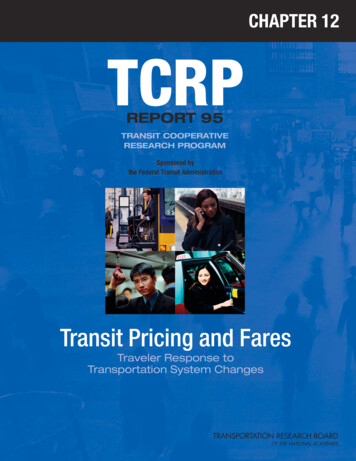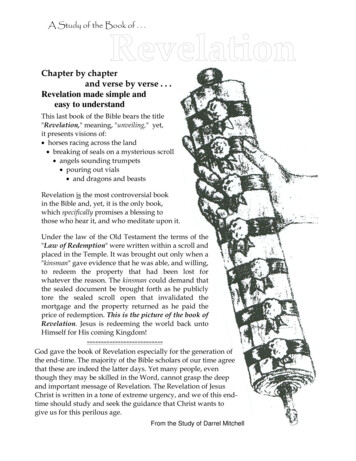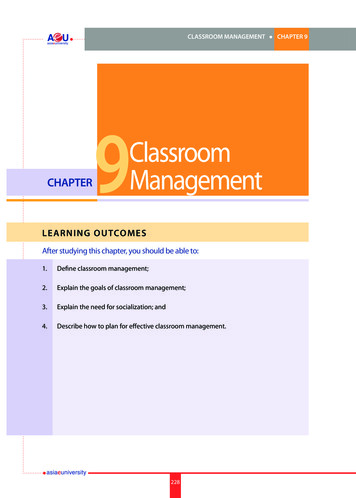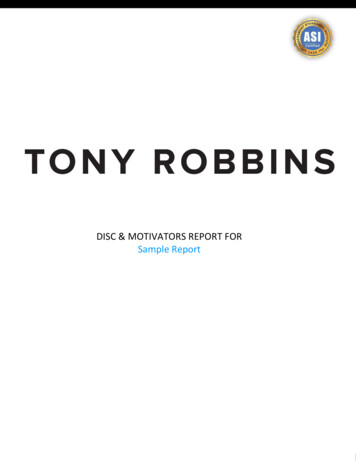
Transcription
CHAPTER 12TCRPREPORT 95TRANSIT COOPERATIVERESEARCH PROGRAMSponsored bythe Federal Transit AdministrationTransit Pricing and FaresTraveler Response toTransportation System Changes
TCRP OVERSIGHT AND PROJECTSELECTION COMMITTEE(as of June 2004)TRANSPORTATION RESEARCH BOARD EXECUTIVE COMMITTEE 2004 (Membership as of July 2004)CHAIRSHARON GREENESharon Greene & AssociatesChair: Michael S. Townes, President and CEO, Hampton Roads Transit, Hampton, VAVice Chair: Joseph H. Boardman, Commissioner, New York State DOTExecutive Director: Robert E. Skinner, Jr., Transportation Research BoardMEMBERSKAREN ANTIONKaren Antion ConsultingLINDA J. BOHLINGERHNTB Corp.ROBERT I. BROWNSTEINParsons Brinckerhoff Quade & Douglas, Inc.PETER A. CANNITOMetropolitan Transit Authority—Metro-NorthRailroadGREGORY COOKAnn Arbor Transportation AuthorityJENNIFER L. DORNFTANATHANIEL P. FORD, SR.Metropolitan Atlanta RTARONALD L. FREELANDParsons Transportation GroupFRED M. GILLIAMCapital Metropolitan Transportation AuthorityKIM R. GREENGFI GENFAREJILL A. HOUGHNorth Dakota State UniversityROBERT H. IRWINBritish Columbia TransitJEANNE W. KRIEGEastern Contra Costa Transit AuthorityCELIA G. KUPERSMITHGolden Gate Bridge, Highway andTransportation DistrictPAUL J. LARROUSSENational Transit InstituteDAVID A. LEEConnecticut TransitCLARENCE W. MARSELLADenver Regional Transportation DistrictFAYE L. M. MOORESoutheastern Pennsylvania TransportationAuthorityMICHAEL H. MULHERNMassachusetts Bay Transportation AuthoritySTEPHANIE L. PINSONGilbert Tweed Associates, Inc.ROBERT H. PRINCE, JR.DMJM HarrisJEFFREY M. ROSENBERGAmalgamated Transit UnionBEVERLY A. SCOTTSacramento Regional Transit DistrictPAUL P. SKOUTELASPort Authority of Allegheny CountyKATHRYN D. WATERSDallas Area Rapid TransitMEMBERSEX OFFICIO MEMBERSWILLIAM W. MILLARAPTAMARY E. PETERSFHWAJOHN C. HORSLEYAASHTOROBERT E. SKINNER, JR.TRBTDC EXECUTIVE DIRECTORLOUIS F. SANDERSAPTASECRETARYROBERT J. REILLYTRBOFFICERSMICHAEL W. BEHRENS, Executive Director, Texas DOTSARAH C. CAMPBELL, President, TransManagement, Inc., Washington, DCE. DEAN CARLSON, Director, Carlson Associates, Topeka, KSJOHN L. CRAIG, Director, Nebraska Department of RoadsDOUGLAS G. DUNCAN, President and CEO, FedEx Freight, Memphis, TNGENEVIEVE GIULIANO, Director, Metrans Transportation Center and Professor, School of Policy,Planning, and Development, USC, Los AngelesBERNARD S. GROSECLOSE, JR., President and CEO, South Carolina State Ports AuthoritySUSAN HANSON, Landry University Prof. of Geography, Graduate School of Geography, Clark UniversityJAMES R. HERTWIG, President, CSX Intermodal, Jacksonville, FLGLORIA J. JEFF, Chief Administrative Officer, Michigan DOTADIB K. KANAFANI, Cahill Professor of Civil Engineering, University of California, BerkeleyRONALD F. KIRBY, Director of Transportation Planning, Metropolitan Washington Council of GovernmentsHERBERT S. LEVINSON, Principal, Herbert S. Levinson Transportation Consultant, New Haven, CTSUE MCNEIL, Director, Urban Transportation Center and Professor, College of Urban Planning andPublic Affairs and Department of Civil and Material Engineering, University of Illinois, ChicagoMICHAEL D. MEYER, Professor, School of Civil and Environmental Engineering, Georgia Instituteof TechnologyCAROL A. MURRAY, Commissioner, New Hampshire DOTJOHN E. NJORD, Executive Director, Utah DOTDAVID PLAVIN, President, Airports Council International, Washington, DCJOHN H. REBENSDORF, Vice Pres., Network Planning and Operations, Union Pacific Railroad Co.,Omaha, NEPHILIP A. SHUCET, Commissioner, Virginia DOTC. MICHAEL WALTON, Ernest H. Cockrell Centennial Chair in Engineering, University of Texas, AustinLINDA S. WATSON, Executive Director, LYNX—Central Florida Regional Transportation Authority,Orlando, FLEX OFFICIO MEMBERSMARION C. BLAKEY, Federal Aviation Administrator, U.S.DOTSAMUEL G. BONASSO, Acting Administrator, Research and Special Programs Administration, U.S.DOTREBECCA M. BREWSTER, President and COO, American Transportation Research Institute, Smyrna, GAGEORGE BUGLIARELLO, Chancellor, Polytechnic University and Foreign Secretary, National Academyof EngineeringTHOMAS H. COLLINS (Adm., U.S. Coast Guard), Commandant, U.S. Coast GuardJENNIFER L. DORN, Federal Transit Administrator, U.S.DOTEDWARD R. HAMBERGER, President and CEO, Association of American RailroadsJOHN C. HORSLEY, Exec. Dir., American Association of State Highway and Transportation OfficialsRICK KOWALEWSKI, Deputy Director, Bureau of Transportation Statistics, U.S.DOTWILLIAM W. MILLAR, President, American Public Transportation AssociationBETTY MONRO, Acting Administrator, Federal Railroad Administration, U.S.DOTMARY E. PETERS, Federal Highway Administrator, U.S.DOTSUZANNE RUDZINSKI, Director, Transportation and Regional Programs, U.S. EPAJEFFREY W. RUNGE, National Highway Traffic Safety Administrator, U.S.DOTANNETTE M. SANDBERG, Federal Motor Carrier Safety Administrator, U.S.DOTWILLIAM G. SCHUBERT, Maritime Administrator, U.S.DOTJEFFREY N. SHANE, Under Secretary for Policy, U.S.DOTCARL A. STROCK (Maj. Gen., U.S. Army), Chief of Engineers and Commanding General, U.S. Army Corpsof EngineersROBERT A. VENEZIA, Program Manager of Public Health Applications, National Aeronautics and SpaceAdministrationTRANSIT COOPERATIVE RESEARCH PROGRAMTransportation Research Board Executive Committee Subcommittee for TCRPMICHAEL S. TOWNES, Hampton Roads Transit, Hampton, VA (Chair)JOSEPH H. BOARDMAN, New York State DOTJENNIFER L. DORN, Federal Transit Administration, U.S.DOTGENEVIEVE GIULIANO, University of Southern California, Los AngelesWILLIAM W. MILLAR, American Public Transportation AssociationROBERT E. SKINNER, JR., Transportation Research BoardC. MICHAEL WALTON, University of Texas, AustinLINDA S. WATSON, LYNX—Central Florida Regional Transportation Authority, Orlando, FL
TRANSIT COOPERATIVE RESEARCH PROGRAMTCRP REPORT 95Traveler Response toTransportation System ChangesChapter 12—Transit Pricing and FaresBRIAN E. MCCOLLOMLead Chapter AuthorRICHARD H. PRATTContributing Chapter AuthorRICHARD H. PRATT, CONSULTANT, INC.Garrett Park, MDTEXAS TRANSPORTATION INSTITUTECollege Station, TXJAY EVANS CONSULTING LLCWashington, DCPARSONS BRINCKERHOFF QUADE & DOUGLAS, INC.Baltimore, MD and San Francisco, CACAMBRIDGE SYSTEMATICS, INC.Chevy Chase, MDJ. RICHARD KUZMYAK, L.L.C.Silver Spring, MDBMI-SGVienna, VAGALLOP CORPORATIONRockville, MDMCCOLLOM MANAGEMENT CONSULTING, INC.Darnestown, MDHERBERT S. LEVINSON, TRANSPORTATION CONSULTANTNew Haven, CTK.T. ANALYTICS, INC.Bethesda, MDS UBJECT A REASPlanning and Administration Public Transit Highway Operations, Capacity and Traffic ControlResearch Sponsored by the Federal Transit Administration in Cooperation with the Transit Development CorporationTRANSPORTATION RESEARCH BOARDWASHINGTON, D.C.2004www.TRB.org
TRANSIT COOPERATIVE RESEARCH PROGRAMTCRP REPORT 95: Chapter 12The nation’s growth and the need to meet mobility,environmental, and energy objectives place demands on publictransit systems. Current systems, some of which are old and in needof upgrading, must expand service area, increase service frequency,and improve efficiency to serve these demands. Research isnecessary to solve operating problems, to adapt appropriate newtechnologies from other industries, and to introduce innovations intothe transit industry. The Transit Cooperative Research Program(TCRP) serves as one of the principal means by which the transitindustry can develop innovative near-term solutions to meetdemands placed on it.The need for TCRP was originally identified in TRB SpecialReport 213—Research for Public Transit: New Directions,published in 1987 and based on a study sponsored by the Urban MassTransportation Administration—now the Federal Transit Administration (FTA). A report by the American Public TransportationAssociation (APTA), Transportation 2000, also recognized the needfor local, problem-solving research. TCRP, modeled after thelongstanding and successful National Cooperative HighwayResearch Program, undertakes research and other technical activitiesin response to the needs of transit service providers. The scope ofTCRP includes a variety of transit research fields including planning, service configuration, equipment, facilities, operations, humanresources, maintenance, policy, and administrative practices.TCRP was established under FTA sponsorship in July 1992.Proposed by the U.S. Department of Transportation, TCRP wasauthorized as part of the Intermodal Surface TransportationEfficiency Act of 1991 (ISTEA). On May 13, 1992, a memorandumagreement outlining TCRP operating procedures was executed bythe three cooperating organizations: FTA; the National Academies,acting through the Transportation Research Board (TRB); andthe Transit Development Corporation, Inc. (TDC), a nonprofiteducational and research organization established by APTA.TDC is responsible for forming the independent governing board,designated as the TCRP Oversight and Project Selection (TOPS)Committee.Research problem statements for TCRP are solicited periodicallybut may be submitted to TRB by anyone at any time. It is theresponsibility of the TOPS Committee to formulate the researchprogram by identifying the highest priority projects. As part of theevaluation, the TOPS Committee defines funding levels andexpected products.Once selected, each project is assigned to an expert panel,appointed by the Transportation Research Board. The panels prepareproject statements (requests for proposals), select contractors, andprovide technical guidance and counsel throughout the life of theproject. The process for developing research problem statements andselecting research agencies has been used by TRB in managingcooperative research programs since 1962. As in other TRB activities, TCRP project panels serve voluntarily without compensation.Because research cannot have the desired impact if products failto reach the intended audience, special emphasis is placed ondisseminating TCRP results to the intended end users of theresearch: transit agencies, service providers, and suppliers. TRBprovides a series of research reports, syntheses of transit practice,and other supporting material developed by TCRP research. APTAwill arrange for workshops, training aids, field visits, and otheractivities to ensure that results are implemented by urban and ruraltransit industry practitioners.The TCRP provides a forum where transit agencies cancooperatively address common operational problems. The TCRPresults support and complement other ongoing transit research andtraining programs.Project B-12A FY’99ISSN 1073-4872ISBN 0-309-08763-5Library of Congress Control Number 2003108813 2004 Transportation Research BoardPrice 20.00NOTICEThe project that is the subject of this report was a part of the Transit CooperativeResearch Program conducted by the Transportation Research Board with theapproval of the Governing Board of the National Research Council. Suchapproval reflects the Governing Board’s judgment that the project concerned isappropriate with respect to both the purposes and resources of the NationalResearch Council.The members of the technical advisory panel selected to monitor this project andto review this report were chosen for recognized scholarly competence and withdue consideration for the balance of disciplines appropriate to the project. Theopinions and conclusions expressed or implied are those of the research agencythat performed the research, and while they have been accepted as appropriateby the technical panel, they are not necessarily those of the TransportationResearch Board, the National Research Council, the Transit DevelopmentCorporation, or the Federal Transit Administration of the U.S. Department ofTransportation.Each report is reviewed and accepted for publication by the technical panelaccording to procedures established and monitored by the TransportationResearch Board Executive Committee and the Governing Board of the NationalResearch Council.Special NoticeThe Transportation Research Board, the National Research Council, the TransitDevelopment Corporation, and the Federal Transit Administration (sponsor ofthe Transit Cooperative Research Program) do not endorse products ormanufacturers. Trade or manufacturers’ names appear herein solely because theyare considered essential to the clarity and completeness of the project reporting.Published reports of theTRANSIT COOPERATIVE RESEARCH PROGRAMare available from:Transportation Research BoardBusiness Office500 Fifth Street, NWWashington, DC 20001and can be ordered through the Internet rinted in the United States of America
The National Academy of Sciences is a private, nonprofit, self-perpetuating society of distinguished scholars engaged in scientific and engineering research, dedicated to the furtherance of science and technologyand to their use for the general welfare. On the authority of the charter granted to it by the Congress in1863, the Academy has a mandate that requires it to advise the federal government on scientific and technical matters. Dr. Bruce M. Alberts is president of the National Academy of Sciences.The National Academy of Engineering was established in 1964, under the charter of the National Academy of Sciences, as a parallel organization of outstanding engineers. It is autonomous in its administrationand in the selection of its members, sharing with the National Academy of Sciences the responsibility foradvising the federal government. The National Academy of Engineering also sponsors engineering programsaimed at meeting national needs, encourages education and research, and recognizes the superior achievements of engineers. Dr. William A. Wulf is president of the National Academy of Engineering.The Institute of Medicine was established in 1970 by the National Academy of Sciences to secure theservices of eminent members of appropriate professions in the examination of policy matters pertainingto the health of the public. The Institute acts under the responsibility given to the National Academy ofSciences by its congressional charter to be an adviser to the federal government and, on its own initiative,to identify issues of medical care, research, and education. Dr. Harvey V. Fineberg is president of theInstitute of Medicine.The National Research Council was organized by the National Academy of Sciences in 1916 to associatethe broad community of science and technology with the Academy’s purposes of furthering knowledge andadvising the federal government. Functioning in accordance with general policies determined by the Academy, the Council has become the principal operating agency of both the National Academy of Sciencesand the National Academy of Engineering in providing services to the government, the public, and thescientific and engineering communities. The Council is administered jointly by both the Academies andthe Institute of Medicine. Dr. Bruce M. Alberts and Dr. William A. Wulf are chair and vice chair,respectively, of the National Research Council.The Transportation Research Board is a division of the National Research Council, which serves theNational Academy of Sciences and the National Academy of Engineering. The Board’s mission is to promoteinnovation and progress in transportation through research. In an objective and interdisciplinary setting,the Board facilitates the sharing of information on transportation practice and policy by researchers andpractitioners; stimulates research and offers research management services that promote technicalexcellence; provides expert advice on transportation policy and programs; and disseminates researchresults broadly and encourages their implementation. The Board’s varied activities annually engage morethan 5,000 engineers, scientists, and other transportation researchers and practitioners from the public andprivate sectors and academia, all of whom contribute their expertise in the public interest. The program issupported by state transportation departments, federal agencies including the component administrations ofthe U.S. Department of Transportation, and other organizations and individuals interested in thedevelopment of transportation. www.TRB.orgwww.national-academies.org
COOPERATIVE RESEARCH PROGRAMS STAFF FOR TCRP REPORT 95ROBERT J. REILLY, Director, Cooperative Research ProgramsCHRISTOPHER W. JENKS, TCRP ManagerSTEPHAN A. PARKER, Senior Program OfficerEILEEN P. DELANEY, Director of PublicationsNATASSJA LINZAU, Associate EditorTCRP PROJECT B-12A PANELField of Service ConfigurationPAUL J. LARROUSSE, National Transit Institute, Rutgers University, NJ (Chair)PATRICK T. DeCORLA-SOUZA, Federal Highway AdministrationKEITH L. KILLOUGH, KLK Consulting, Los Angeles, CAREZA NAVAI, California DOTCYNTHIA ANN NORDT, Houston, TXNEIL J. PEDERSEN, Maryland State Highway AdministrationG. SCOTT RUTHERFORD, University of Washington, Seattle, WADARWIN G. STUART, Skokie, ILRON FISHER, FTA Liaison RepresentativeRICHARD WEAVER, APTA Liaison RepresentativeKIM FISHER, TRB Liaison Representative
FOREWORDBy Stephan A. ParkerStaff OfficerTransportationResearch BoardThis “Transit Pricing and Fares” chapter addresses transit ridership response to farechanges as applied to conventional urban area bus and rail transit services. Topics covered are: changes in general fare level, changes in fare structure including relationshipsamong fare categories, and free transit.This chapter is relatively narrow in its focus. Among other things, it does not coverthe combined outcome of implementing fare and service changes in the same timeframe. This combination, in the case of fare and headway changes, is covered in the“Frequency Changes with Fare Changes” subsection of Chapter 9, “Transit Scheduling and Frequency.” In the case of combined fare and bus routing or service coveragechanges, outcomes are presented in the “Service Changes with Fare Changes” subsection of Chapter 10, “Bus Routing and Coverage.”Special fares, offers and free rides introduced in conjunction with marketing activities are addressed in Chapter 11, “Transit Information and Promotion,” in various subsections within the “Mass Market Promotions” and “Targeted Promotion” categories.General workforce employee transit fare discounts are covered both here in Chapter 12and in Chapter 19, “Employer and Institutional TDM Strategies,” where the emphasisis more on results as seen from an overall Travel Demand Management context.For fare changes applied in the context of certain individual service types, see thefollowing chapters and subtopics: For available express bus fare information, check Chapter 4, “Busways, BRT andExpress Bus.” For public paratransit fare change evaluations, refer to the “Change in Fares” subsection of Chapter 6, “Demand Responsive/ADA” (found in the “UnderlyingTraveler Response Factors” section). For urban rail fare change findings in addition to those presented here in Chapter12, check Chapter 7, “Light Rail Transit,” and Chapter 8, “Commuter Rail.” For results of fare policy and pricing changes affecting local area bus circulatorsand distributors, see the “Circulator/Distributor Routes” subsection of Chapter 10,“Bus Routing and Coverage.”TCRP Report 95: Chapter 12, Transit Pricing and Fares will be of interest to transit planning practitioners; educators and researchers; and professionals across a broadspectrum of transportation agencies, MPOs, and local, state, and federal governmentagencies.The overarching objective of the Traveler Response to Transportation SystemChanges Handbook is to equip members of the transportation profession with a comprehensive, readily accessible, interpretive documentation of results and experienceobtained across the United States and elsewhere from (1) different types of transporta-
tion system changes and policy actions and (2) alternative land use and site development design approaches. While the focus is on conte
Transportation System Changes Chapter 12—Transit Pricing and Fares BRIAN E. MCCOLLOM Lead Chapter Author RICHARD H. PRATT Contributing Chapter Author RICHARD H. PRATT, CONSULTANT, INC. Garrett Park, MD TEXAS TRANSPORTATION INSTITUTE College Station, TX JAY EVANS CONSULTING LLC Washing











